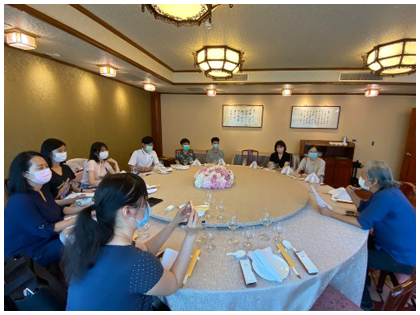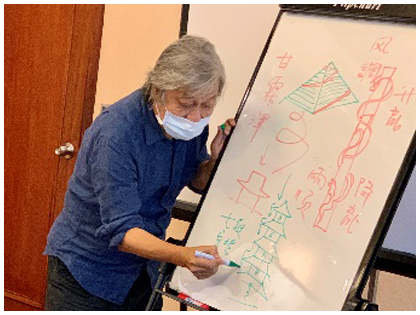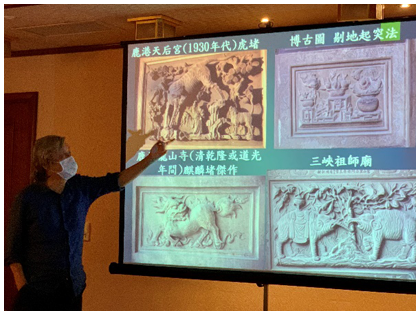Date: Aug 21, 2022 (4-6 pm)
Speech of Historic Sites Master
Introductory Seminar on Historic Site Research by Professor Li Chien-Lang
■Exploring Urban Architecture and Historic Sites
Ever since the COVID-19 pandemic started, we have been prohibited from traveling to foreign nations and restricted from leaving Taiwan’s borders. This has increased the popularity of tourism all around the island. As a result, day studies and research on characteristic buildings in various parts of Taiwan are gradually being promoted and valued. Professor Li Chien-Lang, known as a “walking dictionary of Taiwan’s ancient architecture,” is admired for his belief and passion in promoting the identification, preservation, and maintenance of Taiwan’s ancient architecture. This belief is in sync with the United Nations Sustainable Development Goals (SDGs) of “Sustainable Cities and Communities”, and echoes the theme of the 2023 Expo “BE KIND and UNITE,” which inspired us to become volunteers for the preservation of historic sites. After learning about and appreciating Taiwan’s architecture, we have learned to cherish and appreciate our surroundings. We have learned to great extents about Taiwan’s unique architecture, promotion of architectural maintenance, and how we should cherish the beauty and uniqueness of Taiwan’s many historic sites.

Manuscript of Professor Li’s Introduction to the Seminar
Source: Professor Li Chien-Lang

Source: Professor Li Chien-Lang
We were honored to have invited Professor Li to collaborate with us in organizing an “Introductory Seminar on Historic Site Research” to introduce us to the field of historic site preservation. In the introduction, Professor Li told us that physical historic sites and ancient buildings are the most authentic records of the city. Because of the huge amounts of investment of human and material resources, it is impossible to do whatever you want; architecture is everywhere, it is around you and me, and if you treat it well, it will treat you well in return; architecture carries a story, by appreciating and understanding ancient architecture, we can think of the stories of the ancients; architecture is also a three-dimensional writing, carrying and storing history that cannot be recorded in words, only by on-site visits of the historic site can we understand them deeply; architecture embodies the ideals, life, and wishes of people, reflecting the lifestyles and social organizations of different eras; architecture reflects aesthetics, enhances vision, and purifies people’s hearts.

Professor Li Introducing the Characteristics of Historic Sites
Source: Detective of Historic sites

Professor Li Introducing the Layers of Structure of a Building
Source: Detective of Historic sites
Then Professor Li took us to see the precious architectural photos to compare the differences between Chinese and Western architecture. In the West, geometric buildings such as the Arc de Triomphe are scientifically and precisely designed, while Taiwanese or Chinese buildings are full of curves and warps, as if they were sketched out by a brush, full of fun. In the Eastern traditional architecture, concepts influencing the design include the symmetrical Confucian Buddhism and the arbitrary, asymmetrical Laozhuang Taoism which is full of irregularities. Thus, the form and structure can be very different.

Professor Li Introducing the Concept of Wuxing
(The Five Elements) in Architecture
Source: Detective of Historic sites

Professor Li Introducing the Details of Historic Architecture
Source: Detective of Historic sites
As for the types of ancient buildings in Taiwan, there are various designs and local materials such as schist and thatch because of the different races, climate, and living habits of a particular location. Among them, the aborigines’ architecture is certainly unique, and the design of the Tao people, who live near the sea, and the Bunun people, who live in the high mountains, are completely different. Next, we were introduced the architectural features of the Dutch and Spanish colonial period. The traditional Taiwanese architecture is colorful and incorporates the concept of the five elements, with black representing water, red representing fire, and green representing trees, and the building is painted black when it is fireproof. In addition, temples dedicated to different levels of gods and goddesses are also decorated according to their levels. For example, only big temples can be painted with dragons. Finally, Professor Li showed us many architectural photos to learn about the changes of Taipei City, comparing the historical sites in Taipei from the past to the present, such as the ancestral building Chen De Xing Hall, the market building Ximen Red House, the assembly building Zhongshan Hall, the administrative building Governor’s Office in the past and the current Presidential Office, and the characteristic buildings Taipei Guest House, CKS Memorial Hall, Taipei Post Office, and Taipei Railway Station, which all have different levels of renovation due to the changes of the times and different functions. In the end, the professor encouraged us by emphasizing that architecture is a valuable cultural asset, and “reading” architecture can inspire our imagination and creativity; at the same time, it is also important to promote the love and friendly living environment. Professor Li’s seminar was very informative and rewarding, and it also started the learning journey for the six of us, now in a collective pursuit as the Historic Site Detectives.

